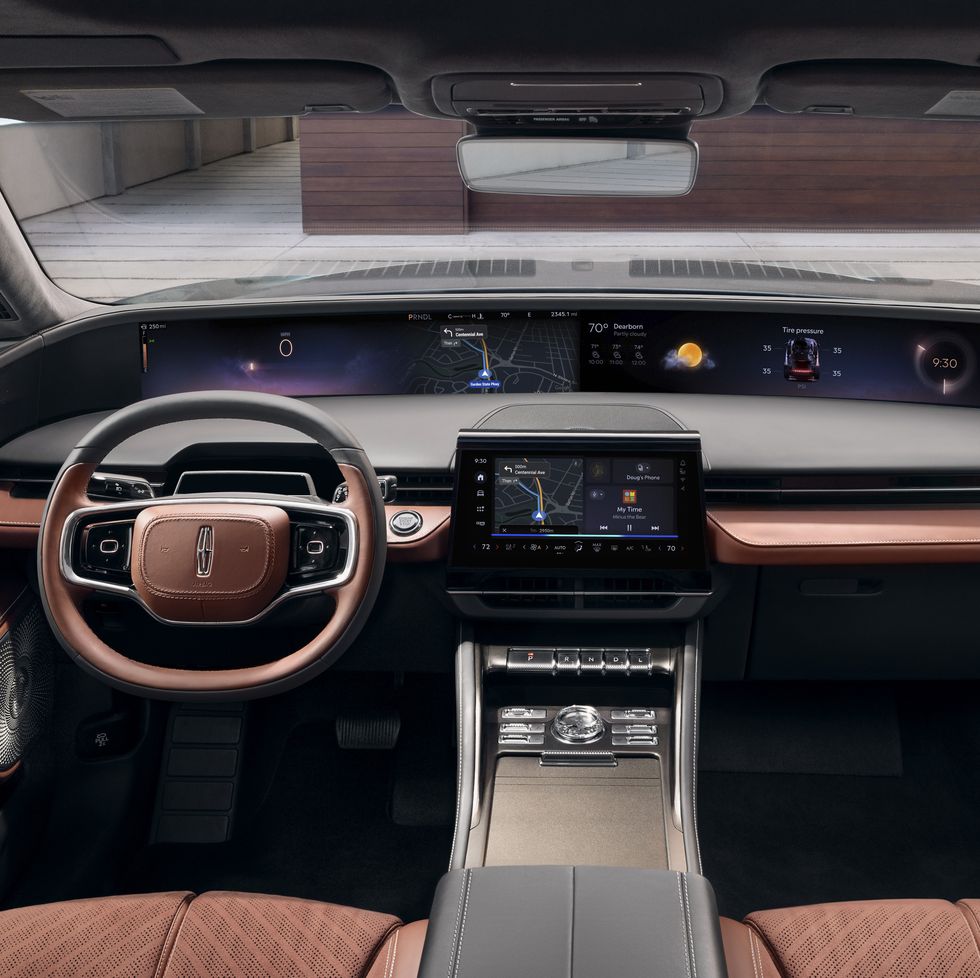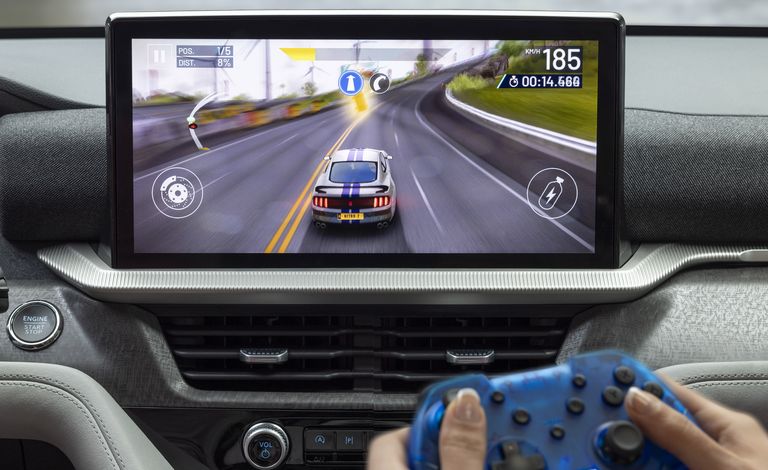
- After first showing it on the 2024 Lincoln Nautilus, Ford has now revealed more details of its latest infotainment system, dubbed Digital Experience.
- Along with smartphone mirroring, the Google Play store allows owners to download apps like Spotify and Waze to the native infotainment system.
- The system also allows you to watch YouTube or Amazon Prime Video while stationary, along with playing video games with a Bluetooth-connected controller.
The 2024 Lincoln Nautilus’s debut last spring brought a vast 48-inch screen spanning the width of the dashboard. But the dazzling display is just one component in a new infotainment system that promises to better connect customers with the digital services they are familiar with. Now Ford has revealed more details on how the new Android Automotive–based system, called “Digital Experience,” works and what to expect from the infotainment in Ford and Lincoln vehicles this decade.
Apps Galore
The main intent of Ford’s new setup is to seamlessly integrate the customer’s electronic devices with their vehicle, turning the car into yet another connected device in the owner’s “digital ecosystem.” The company highlights a study showing that the average U.S. household has 16 connected devices and that the average American spends more than one hour per day driving.
This easiest way to make customers feel at home is to incorporate well-known apps into the native system. While users can still mirror their phone via Apple CarPlay and Android Auto, the Ford and Lincoln system also allows owners to download apps like Spotify and Waze directly into the system via the Google Play store. Once signed in, drivers can always access their accounts on these services even if their phone isn’t in the car. Google Maps also comes preloaded into the system as the primary navigation method.
While parked, the system will also allow owners to stream video via apps including YouTube and Amazon Prime Video on the lower touchscreen. We tested out this out on a pre-production Nautilus at a media event by watching the latest from Car and Driver‘s YouTube channel, and the video loaded quickly, with audio levels controlled by the same knobs and dials as the radio’s volume. The Google Play store even allows for downloading games, and we sampled the racing game Asphalt Nitro 2 on a demonstration unit using a Bluetooth-connected controller. The built-in Vivaldi web browser will soon be joined by Google Chrome, and Ford is also planning to add video conferencing apps.
Customizable Panoramic Screen
On the Nautilus, the lower touchscreen controls what is displayed on the 48-inch panoramic screen, said to be the highest-resolution display ever offered on a Lincoln. The screen sits just below eye level, which Ford says keeps drivers’ eyes focused on the road while still allowing them to quickly ingest vital information. The widescreen display is organized in three planes—”critical” information like speed and BlueCruise status sits directly in front of the driver, while important “supportive” information, like navigation, sits in the middle, and “glanceable” info, like weather and tire pressure, lives in front of the passenger’s seat.
The “glanceable” section of the panoramic screen is composed of three spots for widgets, which can be exchanged by dragging and dropping the different apps into each spot on the touchscreen. In our hands-on experience with the demonstration unit, we found the system to be responsive and intuitive. Only a few widgets are currently available, but we expect the list to grow, with Ford hinting that video content and games could end up on the panoramic screen in the future. A “Calm” button removes all but the most critical info from the panoramic screen. A demo version of the Ford infotainment system at the media event had the touchscreen controlling a smaller digital gauge cluster that would sit behind the steering wheel.
Ford designed the system around voice activation, which the company says will help all customers—even those who feel less comfortable navigating touchscreens—access the functions they need. Google Assistant will be the default, but Alexa is also offered as an alternative for in-vehicle controls such as climate and navigation. When using CarPlay, Siri can activate related functions.
Ford’s point of view is that voice assistants are safer than tapping a screen while driving, and many setup needs will already be taken care of via driver profiles that will load preset preferences for apps, favorite destinations, and seating and mirror positions when each driver enters the vehicle.
A More Powerful System

The Ford and Lincoln Digital Experience is claimed to be the fastest system ever offered by either brand, with five times faster main processing and almost 14 times faster graphics processing. Ford also touts four times the memory and eight times the storage compared with the previous Ford Sync 4 system. The system will have 5G wireless connectivity, an available Wi-Fi hotspot, and over-the-air software updates.
While the system is based on the Android Automotive architecture, the automaker claims it is developing more of the software in-house to allow for quicker updates. This is also benefited by a transition from two separate modules for the gauge cluster and infotainment system to just one overarching module controlling the entire system.
The first vehicle to debut the new Digital Experience is the 2024 Nautilus, which is also the first to feature the full-width screen. Ford said that the panoramic display is a Lincoln exclusive at the moment, but we wouldn’t rule it out for future high-end Ford vehicles. Expect most Fords to sport a simpler setup. The automaker said the first Ford vehicle with the new Digital Experience system will debut soon, which will give a better sense of how the new system will manifest itself without the panoramic screen.
